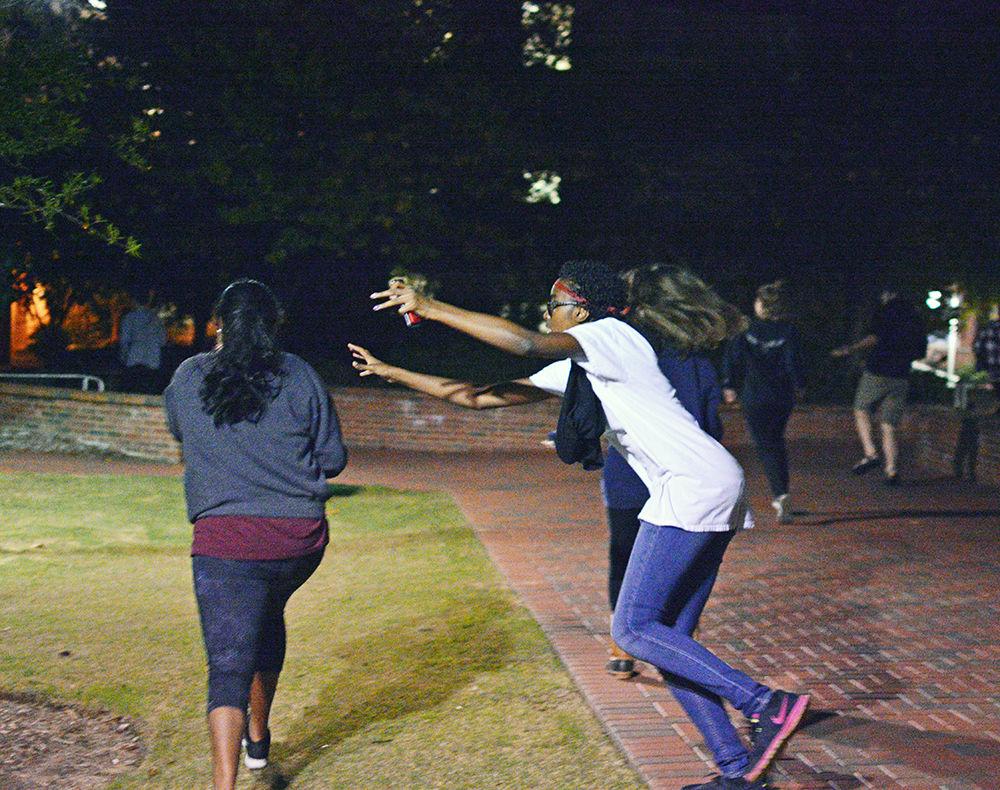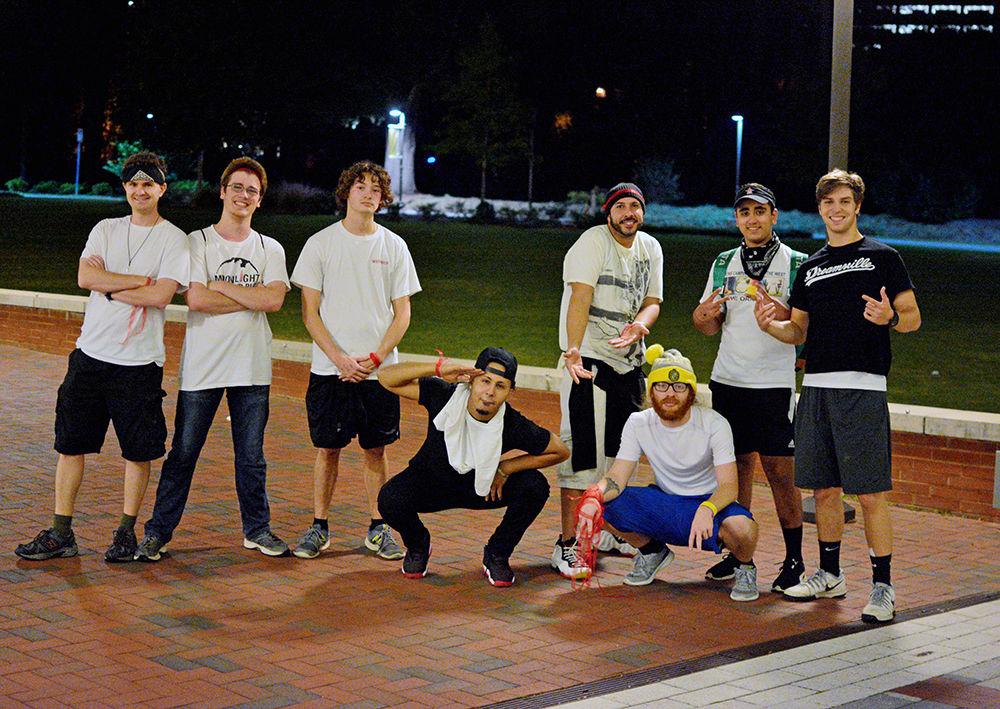While many students dressed as superheroes, animals and memes this past Saturday for some early Halloween celebration, around 150 people chose to wear solid black or white t-shirts and red bandanas. They may not have been the flashiest costumes, but these shirts represented life and death in the game known as Survive Raleigh.
Survive Raleigh is a campus wide game of zombie tag. Players met in Stafford Commons dressed in black, the color used to represent “human” players. Their objective, spend the next two and a half hours dodging students dressed in white, the color used to represent the living dead. This free game, while simple in nature, transforms campus into dead ends, horrifying wide-open spaces and elusive checkpoints, the side objective of human players. If you are “caught” (tagged), you swap your black shirt for a white t-shirt and join the hunt.
Before the 7:30 p.m. start time, human and staring zombies alike plan out their strategies. Luke Weaver, an NC State graduate and a human player participating in the game for the first time, discussed his expectations for the event.
“I’m expecting there will be a lot of running, a lot of sweating, hopefully not many tears, hopefully not much blood, but you never know,” Weaver said. “I don’t have a huge strategy besides keeping a broad look of the area, making sure it’s open before I go out. If I see some white shirts, I’m probably going to think through it and maybe go another direction. I’m trying not to get cornered, because sometimes they’ll team up on you.”
Some students form teams of humans at the event or come with groups of friends. Maps marking checkpoints are only handed out fifteen minutes before the start of the game, so students have to strategize fast. Some, like Josh Jensen, a first-year studying political science, and Jack Gainey, a first-year studying agriculture business, had interesting ideas for how to stay alive.
“He’s [Jensen] going to do something to get me caught,” Gainey said. “We have a not-so-athletic friend, and I’m going to let him go first and get caught. And then I’m going to use this one [Jensen] to run on ahead so they [zombies] go after him while I sneak up from behind and go for the points.”
Gainey said he had not yet planned for a scenario after both of his teammates were caught, but said he was confident he would think of something. Gainey and Jensen both discovered the event only 20 minutes before it began.
“It’s a three-hour event and there are a lot of checkpoints,” Jensen said. “That’s going to be hard.”
There are four main checkpoints in Survive Raleigh roughly representing the four corners of campus. Checkpoints act as safe zones where players cannot be tagged, and students who reach them have their hands stamped to prove their skills and earn themselves points.
“I picked the checkpoints by what points were the furthest from Talley,” said Deshawn Utley, Survive Raleigh’s primary event organizer. “I picked a location near the Belltower, near Weisiger-Brown Athletics Center, Wolf Village — which is the furthest part of campus — and then I made Governor Scott Courtyard a checkpoint. I’m glad that I spread the checkpoints out pretty far.”
The mad dash to checkpoints starts off Survive Raleigh with intense action, but the event quickly turns into a game of endurance, or of stealth. The 150 human players quickly dwindle in the first hour as groups of friends are broken up by differences in athleticism, or by unexpected hordes of zombie players. With at least a full circle of Central and North Campus required to collect each checkpoint, it simply becomes too hard for all but the most fit players to keep running, or outrunning, as the night goes on.
Diving into bushes or ducking behind corners become key strategies and full sprints become more difficult to pull off. Catching a glimpse of anyone wearing white instantly triggers adrenaline and more than a little fear. For zombie players, leaves crunching could be a squirrel, or it could be a new target. Checkpoints become hard to enter and even harder to leave as more and more players get caught.
This year’s game was more challenging than years past because checkpoint locations were kept somewhat hidden. Players received maps with general areas like Wolf Village circled, but the actual checkpoint would not be in the center of the living complex like years past. Instead, in the case of Wolf Village, the checkpoint was tucked away in one of the parking lots surrounding the area. This made surviving in the highly trafficked checkpoint areas difficult.
Utley said this was done intentionally to keep the game fresh and challenging for veteran players. At the end of the evening, surviving players returned to Talley Student Union. Eleven surviving human players arrived for the event’s end. Only one player managed to survive the entire game with all four checkpoints collected, as well as with two bonus checkpoints hidden on campus. The ending ceremony is also a chance for zombies to compare kills, which are collected by taking a player’s bandana after a successful catch.
During the closing, a player showed up dressed in a full redneck leatherface-style costume with his face covered. He took off his backpack and dumped out a pile of 14 captured bandanas, enough kills to earn the title of best zombie. This player was one of the starting zombies in the game and an NC State student. John Kripner, a second-year in the inter-college transfer program, said he didn’t expect to beat out other veteran players.
Kripner, the zombie student with the most kills, said he mostly caught players at the Weisiger-Brown checkpoint, which was the darkest checkpoint in the game. After a successful night of catching, Kripner quickly went home to change into his Halloween costume.
“I have no stamina so I tried to be sneaky,” Kripner said. “I acted like I didn’t see a group of people hiding behind a bush. As they kept moving towards a checkpoint, I slowly followed them until they turned into a dead end. It was kind of like in a horror movie. I walked up and tagged each one of them in a row. They didn’t even hear me coming.”
According to Utley, another Survive Raleigh style game is being planned for March of next year.
“There will be a lot more improvements for March, but I can’t say what just yet,” Utley said. “I’m always taking suggestions.”
Participants of Survive Raleigh pose for a group picture on Oct. 28. The game involves zombies wearing white shirts trying to tag humans wearing black shirts. To win, a human must make it to all four checkpoints without getting tagged by a zombie.














